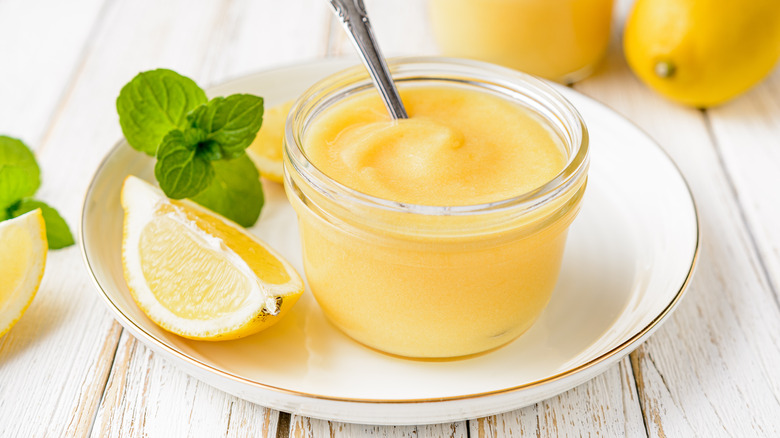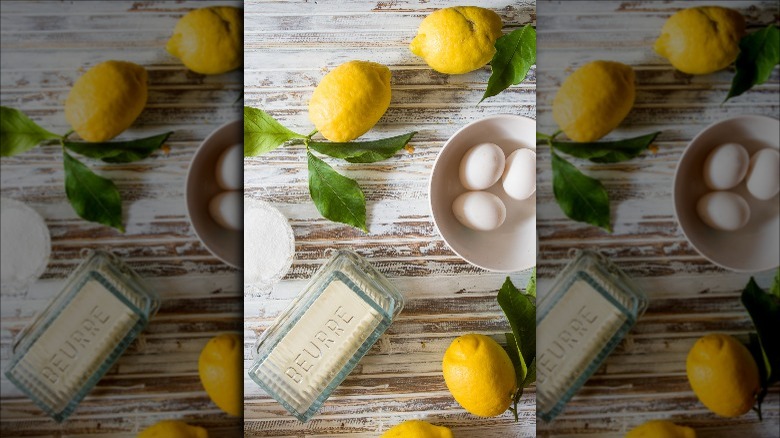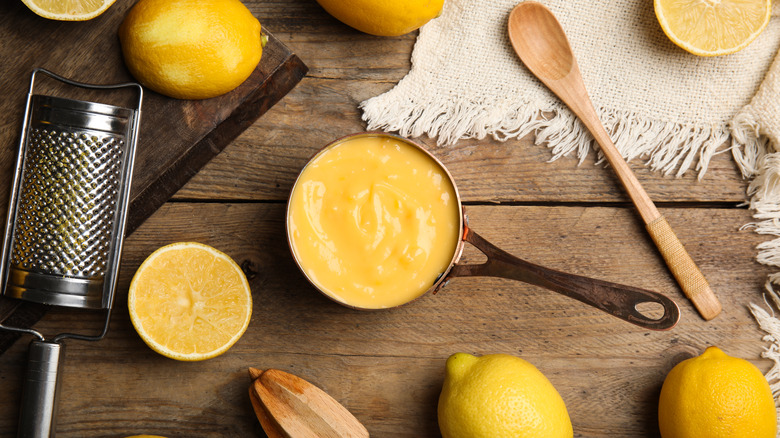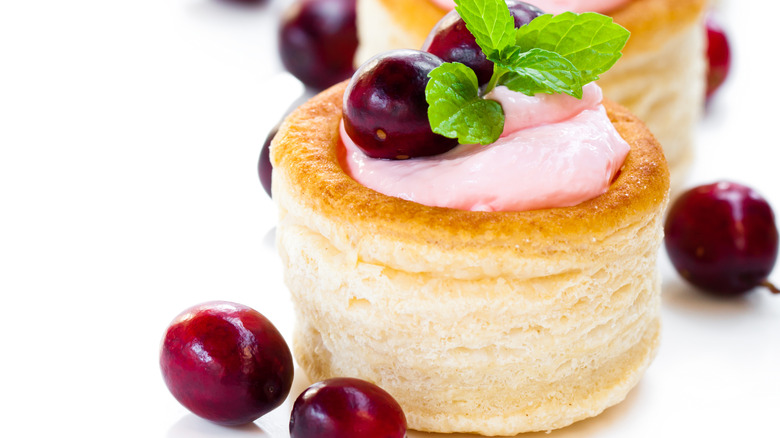What Is Lemon Curd And What Does It Taste Like?
Lemon curd is an inherently British fruit spread used as a topping on toast or scones, as an alternative to jam or jelly, or as filling in pastries or cakes. Tangy, sweet, silky, and smooth like a glossy custard but a bit lighter, Spruce Eats says that it is often referred to as "lemon cheese" across the pond, where it was introduced in the nineteenth century (via Barker's). As the outlet explained, the inaugural fruit curds were not as sweet or creamy as today's delicate incarnations, they were the result of acidulating cream with lemon juice, forming curds, and separating them from the whey via cheesecloth.
Many Americans first learned of the uniquely textured concoction when Meghan Markle, already asserting her propensity for bucking British tradition, chose to forego the traditional fruitcake that Brits typically serve up at weddings, and chose an elderflower and lemon curd creation for her wedding cake.
Curds and whey, made famous by that little miss and her spider, are the result of cheese-making. As described by Grammarist, the process involves incorporating rennet, an enzyme, into milk, which causes the milk to curdle into solid lumps, or curds. Miss Muffet's ill-fated meal was likely very similar to what we today call cottage cheese.
What are the ingredients for lemon curd?
Lemon curd is made from sugar, butter, eggs, lemon juice, and lemon zest, cooked low and slow to avoid curdling. Many recipes call for Meyer lemons, though that's a matter of preference, as regular old lemons are just fine (via Pinch Me I'm Eating).
Lemon curd is not lumpy, but silky smooth. It's typically a bright yellow in color, thanks to the egg yolks more than the lemon, although it can take on a greenish hue if prepared in aluminum or copper pans. As Taste of Home explained, these types of pans should be avoided. The dairy used is butter, not milk, and the key ingredient is the lemon, which, apart from lending the substance it's delectable tartness, denatures the proteins (eggs), increasing the emulsion stability and giving it the unique glossy texture that defines it (via Crafty Baking). The sugar raises the coagulation point of the eggs, which helps prevent the formation of the afore-mentioned solids, or curds.
How is lemon curd made?
Lemon curd is typically prepared in a double boiler, but can be made in the microwave as well. Recipes vary greatly as to how and when to incorporate the ingredients; Some suggest creaming the butter and sugar first, then adding the eggs, while others tell you to mix the eggs or egg yolks with the sugar and then add the butter. The lemon juice is typically added after the curd has thickened. Making sure the eggs don't scramble and the substance doesn't curdle is really the ticket with this tangy tongue-pleaser, and most versions include the straining of the substance, using that time-honored strainer, the cheesecloth.
According to Simply Recipes, the devil is in the details of the incorporation of the fairly simple ingredients, and the finished product should hold together like a pudding, feel creamy and smooth on the tongue, be devoid of curds or lumps, and boast the perfect balance of tart and sweet flavors. Sounds simple, right?
Though the preparation of this treat may take a little practice, it is, indeed, fairly simple, and the resulting burst of lemon flavor, and its unique consistency, make preparing lemon curd yourself well worth the effort.
Variations and varieties of lemon curd
If the thought of cheesecloths and curdle-anxiety are too much for you, there are some really good store-bought versions, by Trader Joe's, Bonne Maman, and Harry and David, to name a few. That said, the homemade version is a really yummy, fun cooking project, and topping a scone or freshly-baked biscuit with your own homemade lemon curd can really make friends and influence people.
According to Taste of Home, two tablespoons of lemon curd contains 110 calories, 5g of fat, 52 mg of cholesterol, 45mg of sodium, 16g carbohydrate, and 2g of protein. The sweet spread should last up to two weeks in the fridge, and can also be frozen.
While lemon curd is the most popular of the fruit curds, orange, lime, or even grapefruit lend themselves well to the silky stuff, and watermelon curd is a fun summer treat. If you're racking your brain as to what to serve alongside the requisite pumpkin pie as an end to the impending meal marathon, cranberry curd can be a welcome accompaniment, sure to impress the in-laws, and perhaps provide a conversation starter that won't lend itself to a food fight.



